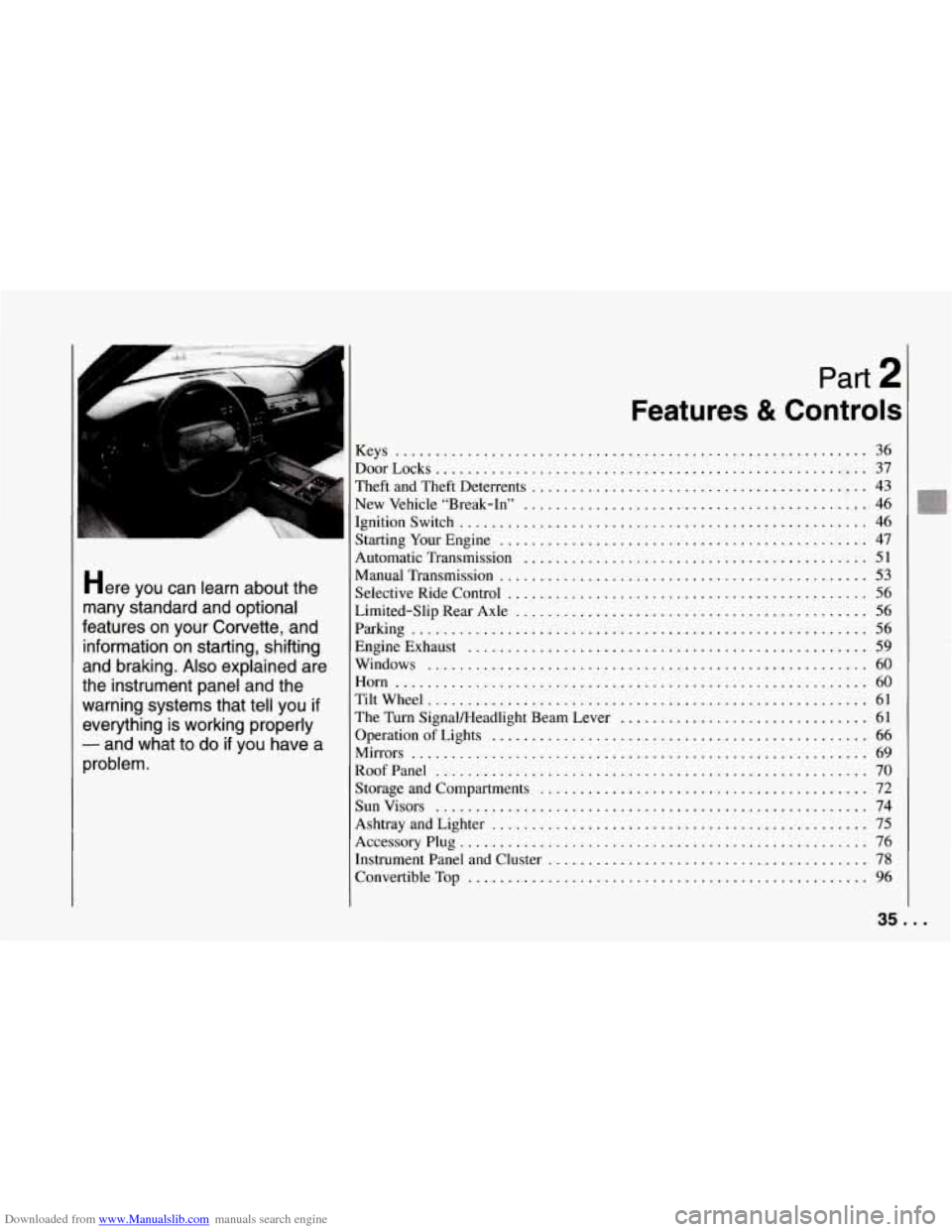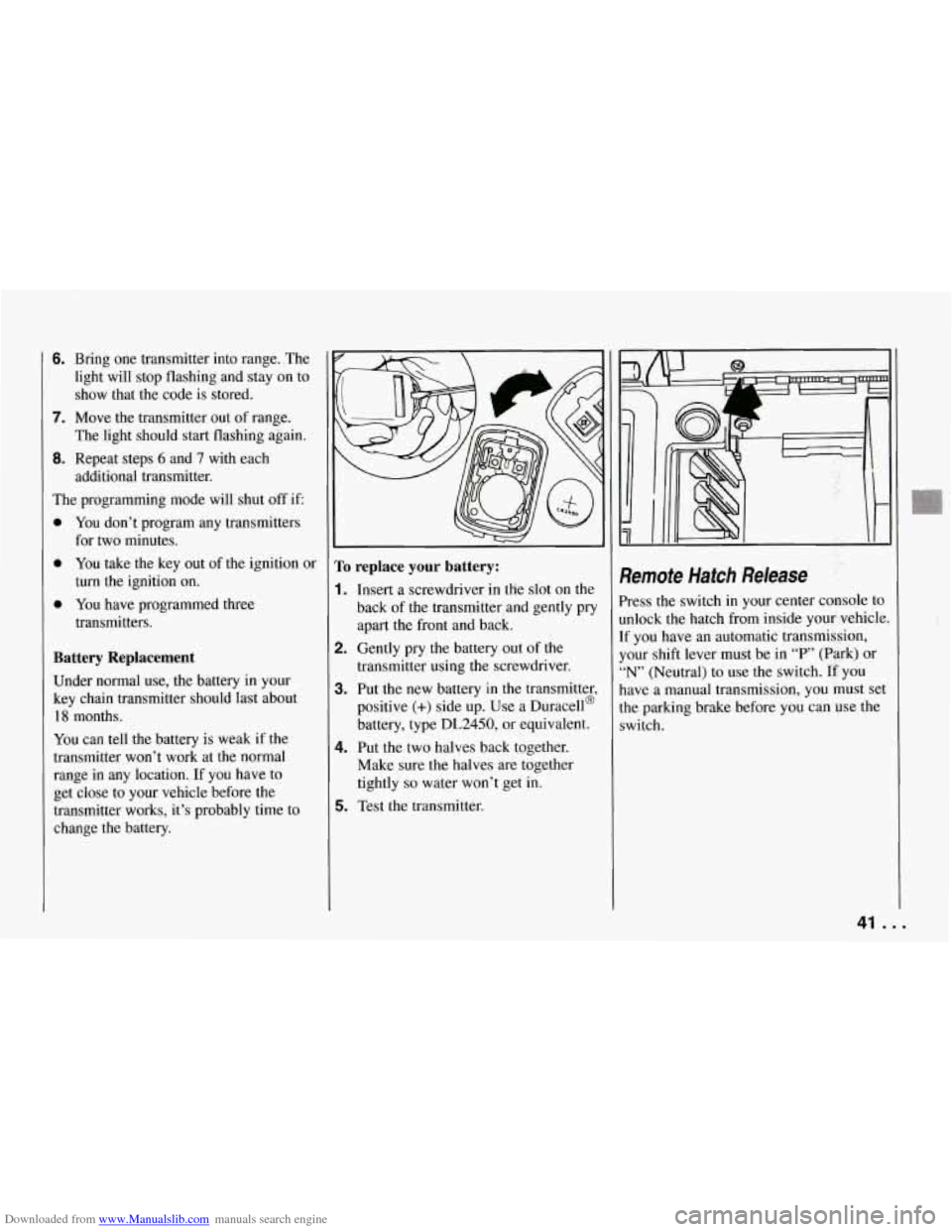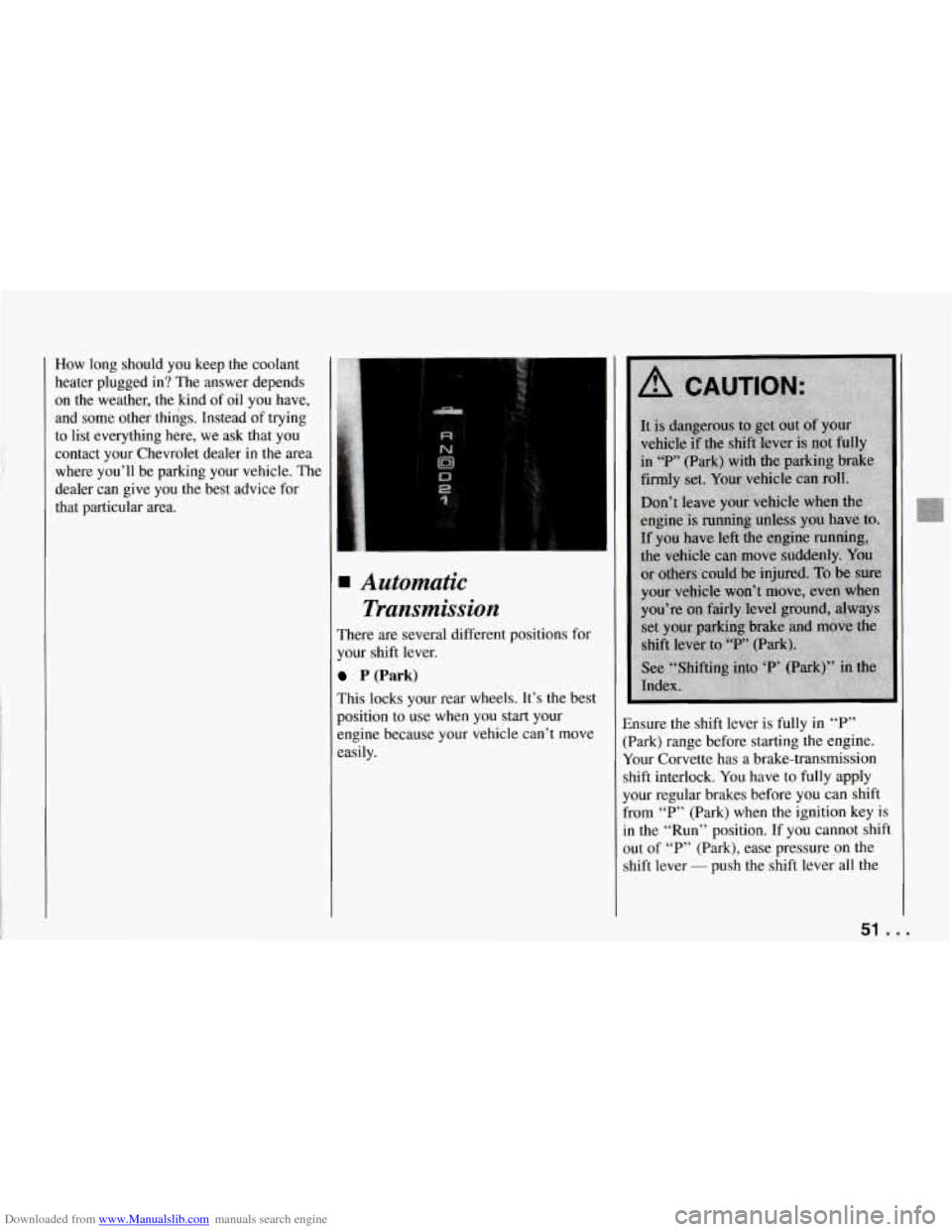1994 CHEVROLET CORVETTE automatic transmission
[x] Cancel search: automatic transmissionPage 4 of 274

Downloaded from www.Manualslib.com manuals search engine In the early ’50s, is was only a
designer’s dream. Today, the Corvette
stands alone as America’s dream car
- a
testament to its unmistakable charisma
and the excitement it inspires. Unique
styling, powerful performance and an undeniable panache have made Corvette
one of the most celebrated sports cars
in
the world.
In 1953, Chevrolet produced 300 new
lightweight fiberglass roadsters.
A
handful went to project engineers,
General Motors managers, and a select
group of movie stars and celebrities.
With a two-speed Powerglide automatic
transmission, Blue Flame six-cylinder
engine, and gleaming Polo White
exterior, Corvette began its drive into
the heart
of America.
Designers freshioned up the ’Vette in
1956 by adding a removable hardtop
and the famous Corvette “coves.” The
sculptured body enhanced its sporty
look, and a standard 2 10-horsepower
Chevy
V8 engine solidified Corvette’s
reputation as a production race car.
Page 36 of 274

Downloaded from www.Manualslib.com manuals search engine A
Part 2
Features & Controls
Keys ........................................................... 36
DoorLocks
...................................................... 37
Theft and Theft Deterrents
.......................................... 43
New Vehicle “Break-In”
........................................... 46
IIgnitionSwitch
................................................... 46
Starting Your Engine
.............................................. 47
Automatic Transmission
........................................... 51
Manual Transmission
.............................................. 53
many standard and optional Limited-Slip Rear Axle ............................................ 56
Parking 56
Here You can learn d3out the Selective Ride Control ............................................. 56
features on your Corvette. and .........................................................
information on starting. shifting Engine Exhaust .................................................. 59
and braking . Also explained are Windows ....................................................... 60
........................................................... the instrument panel and the Horn 60
warning systems that tell you if Tiltwheel 61
everything is working properly The Turn SignaVHeadlight Beam Lever 61
- and what to do if you have a OperationofLights 66
Mirrors
......................................................... 69 problem . RoofPanel ...................................................... 70
Sunvisors
...................................................... 74
.......................................................
...............................
...............................................
Storage and Compartments ......................................... 72
Ashtray and Lighter
............................................... 75
Accessory Plug
................................................... 76
Instrument Panel and Cluster
........................................ 78
ConvertibleTop
.................................................. 96
35 ...
Page 42 of 274

Downloaded from www.Manualslib.com manuals search engine 6. Bring one transmitter into range. The
light will stop flashing and stay on to
show that the code is stored.
7. Move the transmitter out of range.
8. Repeat steps 6 and 7 with each
The programming mode will shut
off if:
0 You don’t program any transmitters
0 You take the key out of the ignition or
0 You have programmed three
The light should
start flashing again.
additional transmitter.
for two minutes.
turn the ignition on.
transmitters.
Battery Replacement
Under normal use, the battery in your
key chain transmitter should last about
18 months.
You can tell the battery is weak if the
transmitter won’t work at
the normal
range in any location.
If you have to
get close to your vehicle before the
transmitter works, it’s probably time to
change the battery.
ro replace your battery:
I. Insert a screwdriver in the slot on the
back
of the transmitter and gently pry
apart the front and back.
2. Gently pry the battery out of the
transmitter using the screwdriver.
3. Put the new battery in the transmitter,
positive
(+) side up. Use a Duracell@
battery, type DL2450, or equivalent.
4. Put the two halves back together.
Make sure the halves are together
tightly
so water won’t get in.
5. Test the transmitter.
?emote Hatch Release
’ress the switch in your center console to
mlock the hatch from inside your vehicle
f you have an automatic transmission,
[our shift lever must be
in “P’ (Park) or
‘N’ (Neutral) to use the switch. If you
lave a manual transmission, you must sei
he parking brake before you can use the
;witch.
..
.i ,
41 ...
Page 44 of 274

Downloaded from www.Manualslib.com manuals search engine NOTICE:
If you put things in the hatchback
area, be sure they won’t break the
glass when
you close it.
Never slam the hatch down. You
could break the glass or damage the
defogger grid.
When you close the hatch, make sure
you pull down from the center, not
the sides. If you pull the hatch down
1 from the side too often, the weather-
1 strip can be damaged.
Theft
Vehicle theft is big business, especially in
;ome cities. Although your Corvette has a
lumber of theft-deterrent features, we
mow that nothing we put on
it can make
It impossible to steal. However, there are
ways you can help.
Key in the Ignition
[f you walk away from your vehicle with
the keys inside, it’s an easy target for joy
riders or professional thieves
- so don’t
do it.
When you park your Corvette and open
the driver’s door, you’ll hear a tone
reminding you to remove your key from
the ignition and take it with you. Always
do this. Your steering wheel will be
locked, and
so will your ignition. If you
have an automatic transmission, taking
your key out also locks your transmission.
And remember to lock the doors.
Parking at Night
Park in a lighted spot, close all windows
and lock your vehicle. Remember to keep
your valuables out of sight. Put them in a
storage area, or take them with you.
Parking Lots
If you park in a lot where someone will be
watching your vehicle, it’s best to lock it
up and take your keys. But what if you
have to leave your ignition key? What
if
you have to leave something valuable in
your vehicle?
0 Put your valuables in a storage area,
0 Lock the storage area.
Lock all the doors except the driver’s.
0 Then take the door key with you.
like the rear area or center console.
43 ...
Page 47 of 274

Downloaded from www.Manualslib.com manuals search engine Features and Controls
NOTICE:
Your modern Corvette doesn’t need
an elaborate “break-in.” But it will
perform better in the long run if you
follow these guidelines:
0 Keep your speed at 55 mph
(88 km/h) or less for the first
500 miles (804 km).
Don’t drive at any one speed
- fast or slow - for the
fist
500 miles (804 km).
Don’t make full-throttle
starts.
Avoid malung hard stops for
the first
200 miles (322 km)
or so. During this time your
new brake linings
aren’t yet
broken in.
Hard stops with
new linings can mean
premature wear and earlier
replacement. Follow this
“breaking-in” guideline
every time you get new
brake linings.
I
Ignition Switch
With the ignition key in the ignition
switch, you can turn the switch to five
positions:
Acc (A): Position in which you can
operate your electrical power accessories.
Press in the ignition switch as you turn
the top of it toward you.
Lock (B): The only position in which
you can remove the key. This locks your
steering wheel, ignition and automatic
transmission.
If you have an automatic transmission, tht
ignition switch can’t be turned to “Lock”
unless the shift lever
is in the “P” (Park)
position.
... 46
Off (C): Unlocks the steering wheel,
ignition and automatic transmission, but
does not send electrical power to any
accessories. Use
this position if your
vehicle must be pushed
or towed.
Run (D): Position to which the switch
returns after you start your engine and
release the switch. The switch stays in
the “Run” position when the engine is
running. But even when the engine is not
running, you can use “Run” to operate
your electrical power accessories and to
display some instrument panel warning
and indicator lights.
Start (E): Starts the engine. When the
engine
starts, release the key. The ignition
switch will return to “Run” for normal
driving.
When the engine is not running, “Acc”
and “Run” allow you to operate your
slectrical accessories, such as the radio.
A warning tone will sound if you open
the driver’s door when the ignition is in
“Off,’’ “Lock” or “Acc” and the key is in
the ignition.
Page 48 of 274

Downloaded from www.Manualslib.com manuals search engine Ke
ma
ha! the
ou1
!y Release Button: If you have a
lnual transmission, your ignition lock
; a key release button. You must press
: button before you can take your key
t of the ignition lock.
NOTICE:
If your key seems stuck in “Lock”
and you can’t turn it, be sure it is all
the way in. If it is, then turn the steer-
ing wheel left and right while you
turn the key hard. But turn the key
only with your hand. Using a tool to
force it could break the key or the
ignition switch. If none of this works,
then your vehicle needs service.
Delayed Accessory Bus (DAB)
With DAB your power windows and the
audio system will continue to work up to
15 minutes after the ignition key is turnec
to “Off’ and neither door is opened.
If a
door is opened, the audio system and
power windows will shut
off.
Starting Your Engine
Automatic Transmission: Move your
shift lever to
“P’ (Park) or “N” (Neutral).
Your engine won’t start in any other
position
- that’s a safety feature. To
restart when you’re already moving,
use
“N” (Neutral) only.
NOTICE:
Don’t try to shift to “P” (Park) if your
Corvette is moving. If you do, you
could damage the transmission. Shift
to
“P” (Park) only when your vehicle
is stopped.
ManuaI Transmission: The gear selector
should be
in neutral. Hold the clutch
pedal to the
floor and start the engine.
Your vehicle won’t start if the clutch
pedal is not all the way down
- that’s a
safety feature.
To start your 5.7 Liter LTl engine:
1. Without pushing the accelerator pedal
turn the ignition key to “Start.” When
the engine starts, let go of the key. Thl
idle speed will go down as your
engine gets warm.
NOTICE:
Holding your key in “Start” for
longer than 15 seconds at a time will
cause your battery to be drained
much sooner. And the excessive heat
can damage your starter motor.
47 ...
Page 51 of 274

Downloaded from www.Manualslib.com manuals search engine Features and Controls
Driving through Deep Standing Water
NOTICE:
If you drive too quickly through deep
puddles or standing water, water can
come in through your engine’s air
intake and badly damage your
engine. If you can’t avoid deep
puddles or standing water, drive
through them very slowly.
Rough Idling
If you notice rough idling or surging,
especially after long periods of idling or
during slow city driving, the oxygen
sensors may be clogged. If this happens,
follow these steps to clear the oxygen
sensors:
1. Set the parking brake.
2. Shift an automatic transmission to “P”
(Park) or a manual transmission to
“N’ (Neutral).
tachometer reads
2,000 rpm and hold
for two minutes.
3. Press the accelerator until your
... 50
Engine Coolant Heater (Engine
Block Heater)
(LTI ENGINE, CANADA)
In very cold weather, 0 “F (- 18 “C) or
colder, the engine coolant heater can help.
You’ll get easier starting and better fuel
economy during engine warm-up.
Usually, the coolant heater should be
plugged in a minimum of four hours prior
to starting your vehicle.
To use the coolant heater:
1. Turn off the engine.
2. Open the hood and unwrap the
electrical cord.
3. Plug it into a normal, grounded
1 10-volt outlet.
I NOTICE:
After you’ve used the coolant heater,
be sure to store the cord as it was
before to keep it away from moving
engine parts. If you don’t, it could be
damaged.
Page 52 of 274

Downloaded from www.Manualslib.com manuals search engine How long should you keep the coolant
heater plugged in? The answer depends
on the weather, the kind of
oil you have,
and some other things. Instead of trying
to list everything here, we ask that you
contact your Chevrolet dealer in the area
where you’ll be parking your vehicle. The
dealer can give you the best advice for
that particular area.
. i:,
Automatic Transmission
There are several different positions for
your shift lever.
P (Park)
This locks your rear wheels. It’s the best
position to use when you start your
engine because your vehicle can’t move
easily. Ensure the shift
lever is fully in
“P”
(Park) range before starting the engine.
Your Corvette has a brake-transmission
shift interlock. You have to fully apply
your regular brakes before you can shift
from “P” (Park) when the ignition key is
in the “Run” position. If you cannot shift
out of
“P” (Park), ease pressure on the
shift lever
- push the shift lever all the
51 ...